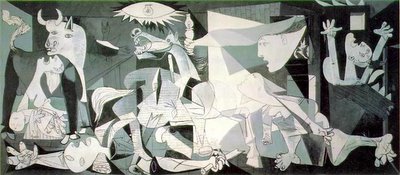
The story behind “el Guernica” begins on the 26th of April 1937. On that infamous date, a squadron of German war planes dropped several tonnes of explosives and firebombs on the Basque town of Guernica. It is unknown how many of the 7000 inhabitants perished in the attack. What is known is that two thirds of the town’s buildings were destroyed. The Times journalist George Steer, witness to the attack, reported that Luftwaffe fighter jets patrolled the outskirts shooting down those who attempted to escape the inferno.
The action served two purposes. The town of Guernica was a symbol of Basque identity. For Franco its destruction was a declaration of intent. A chance to set Guernica as an example to others who dared put in question the unity of Spain. For Goering, as he would later confess during the Nuremberg trials, it was a chance for the Luftwaffe to rehearse the destruction of entire towns.
Picasso’s “El Guernica” is a denunciation of this atrocity. It is the pacifist painting by excellence. The symbols of pain and despair immortalised in this harrowing work take on another dimension when it is seen in its original form. Nothing could have prepared me for the day I saw it in person. Measuring 349 x 777 centimetres, “El Guernica” is a frightening sight.
Spain is until this day a divided country. On one side there are those who think the nationalist government of Franco was virtuous; he imposed order, good moral values and promoted the unity of Spain. On the other there are those who believe Franco was a murderous, fascist dictator. Whenever I hear two people engaged in this discussion - not a rare occurrence, - “El Guernica” comes to my mind: for the day I went to see it I took sides irremediably.
Peace_Mate

1 comments:
I think you should study some history of Spain before that mean that in Spain there are two camps, those who believe that Franco brought order and those who think he was a murderer, that's not true, and at the present time the people who are murdered in cold blood are those terrorists you call Basque identity
Post a Comment